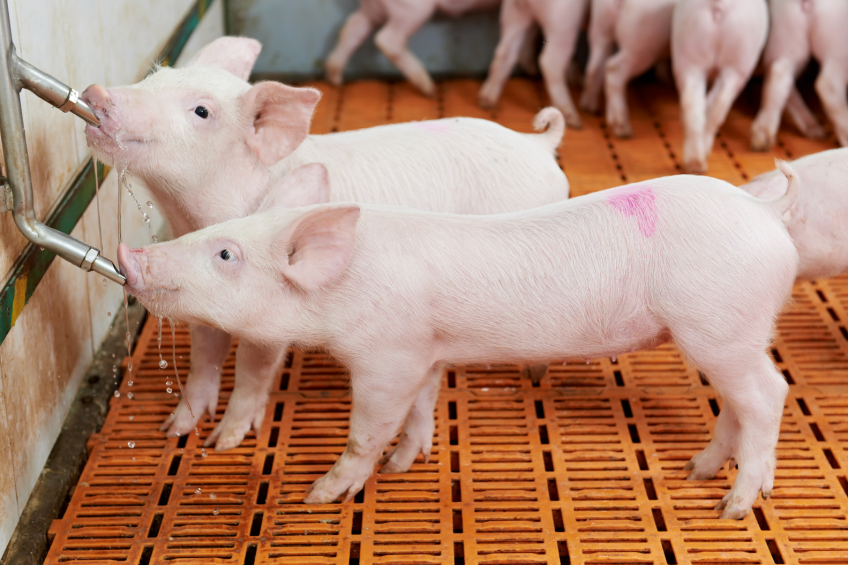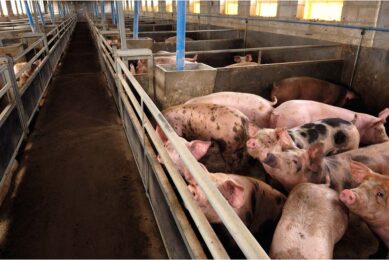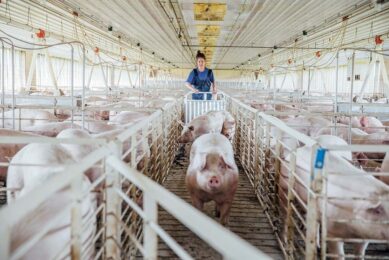Water – much more than just a nutrient

It sounds logical – if pigs are fed liquid feed, why bother supplying drinkers? Surely they will only constitute an additional cost for water ?wastage? The matter is more complex than that. Water answers to the pigs’ biological and behavioural needs.
By Prof Peter Brooks, United Kingdom
Despite having spent three decades explaining why pigs on liquid diets must have a separate supply of water, it is still possible to come across pig producers, equipment manufacturers, building suppliers and even some researchers who think that it is acceptable to deny pigs a separate supply of clean drinking water. It is quite remarkable that any pig producer would consider such a practice acceptable. In no other sector of animal agriculture has it ever been suggested that the animal’s requirement for water could be met by mixing water and food and providing the animal only with the resulting gruel.
So are pigs different? The answer is ‘no’, they are not. Whether fed liquid or dry feed pigs still need a separate water supply. Failing to supply a separate source of drinkable water can compromise pig performance and most definitely compromises pig welfare.
The reasons usually given for denying the pig access to a separate water supply are ill-conceived. The most common arguments are that:
- The pig gets all the water it needs in the liquid feed, therefore the provision of drinkers is an unnecessary capital cost.
- Water wastage and hence slurry volume and environmental load can be reduced if the pigs do not have drinkers to ‘play with’ or that can malfunction and leak.
Both these arguments are false.
Anticipation
The first thing that needs to be appreciated is that we never know how much water a group of pigs, or more importantly each pig within that group, needs. Although modern pigs are more genetically uniform than their predecessors, they are not identical. Consequently, even if we derived an ‘average’ requirement it would be valueless. We do not have herds of ‘average’ pigs. An ‘average’ value is wrong for almost every animal in the population. Consequently, we cannot meet the animal’s biological requirement with a single water:food ratio. So why is water different in this respect from other nutrients? The answer is that water is not just a nutrient.
Biological need
It is extraordinarily difficult to make an assessment of the pig’s water needs. This is because water fulfils a number of different and vital functions. If water was simply a nutrient that accumulated in body tissue (like protein or fat) it would, theoretically, be possible to study water input/output relationships and derive ‘requirement’ values that would satisfy specified production objectives.
However, this approach cannot be used in the case of water. In addition to the ‘nutrient requirement’ for tissue maintenance and growth, for reproduction and lactation, the pig also needs and uses water to fulfil a number of other physiologically and biochemically significant functions, namely for:
- The excretion of the end products of protein digestion;
- The maintenance of mineral homeostasis (particularly for the removal of potassium, sodium and chloride);
- Detoxification (removal of natural toxicants, anti nutritional factors and drug residues from the body);
- The achievement of satiety (gut fill);
- The satisfaction of behavioural drives;
- The adjustment of body temperature.
There are two important points to make about this list of functions. First, these uses of water create ‘needs’ or ‘requirements’ that may be both additive and in addition to the nutritional requirements for body maintenance and production. The classic ‘nutritional’ requirement is a minimum value that is only operative if, by chance, the other needs have been met within a given situation. Secondly, some of the functions listed above have a higher priority than production. This means that if the water supply is not adequate to support all the needs of the animal, prioritisation of those other functions will result in an under supply of water to support production. The consequence of this is that animal performance with be reduced.
Let’s explore some of these other needs more closely. The pig has a limited ability to concentrate waste products in its urine. Therefore, any increase in waste products needing elimination requires an increase in water intake and hence urine output. The relationship between the quantity and quality of protein in the diet and the pig’s water requirement is often overlooked. Amino acids that are not utilised for production are deaminated and the nitrogenous end products are excreted in the urine.
In a Canadian study (Table 1), researchers formulated diets that incorporating synthetic amino acids (low protein diet) to achieve the same essential amino acid content in 17.8% crude protein as in the reference high protein (21.4%). This lower protein diet had little effect on water demand. This is to be expected as the amount of protein being assimilated into production will be similar. However, increasing the total protein content of the diet by 4% units (enough to support 50% more growth) increased water demand by 25%. The extra protein could not be incorporated into tissue and had to be deaminated, increasing the demand for water. In a further treatment they increased the mineral supply to the pigs by around 100%. This increased the water demand by 8%. It is worth noting that the extra water required to deal with excess protein was considerably more than was required when the mineral content was increased.
This does not mean that we can ignore the potential problems caused by mineral excesses in liquid diets. Liquid diets often contain liquid components other than water. Many of these materials can have high and unpredictable mineral content. The mineral content of food co-products, like cheese whey, can vary greatly between batches of the same material.
High salt content is a particular issue with food industry co-products (see Table 2). Co-products including processed food (e.g. bakery products) may contain product originally intended for human consumption that was ’off-spec’ that is it did not fulfil the specification for human food. This can be because there was an error in the recipe used in the cooking process. Processed human food often contains higher levels of salt than we would formulate in pig diets. Increasing the salt concentration in the diet increases the demand for water dramatically (Table 3 and Figure 1). High levels of potassium (a particular issue with some sources of molasses) can also increase water demand (Table 4). It is not just the liquid components, or the more unusual raw materials used in the diet that can cause problems. Conventional raw materials (including different samples of the same raw material) can also have very varied mineral contents, depending on their source and the conditions under which they were grown. The mineral content of the formulated diet may deviate markedly from the expected value. Pigs fed dry diets and given ad lib water rarely suffer as a result of these variations, but liquid fed pigs denied a separate supply of water can. Therefore, as we can never be sure what the precise mineral content of a diet will be, it is imperative that we give the pig the opportunity to adjust its water intake to compensate for these variations.
Mycotoxins and the residues of some pharmaceuticals will also increase water demand for renal clearance; however, as the presence of these is often associated with other clinical changes it is difficult to unscramble the precise cause and effect relationship.
A range of disease conditions increase water demand. For example, a pig suffering from enteric disease will increase water intake to compensate for the loss of fluids in the watery faeces produced. Furthermore, it must be remembered that sick animals may refuse food (even food containing liquid) but may still have a desperate need to drink. For these reasons we should see the provision of a separate water supply as an insurance policy and part of the pig unit’s risk management policy.
Legislation regarding water supply
The issues discussed here have informed the development of European Welfare Legislation. Article 14 of the European Convention for the Protection of Animals kept for Farming Purposes (T-Ap) Recommendation Concerning Pigs, states that:
All pigs shall have appropriate access to adequate, nutritious, hygienic feed each day, and to adequate supplies of water of
suitable quality at all times.
This has been enshrined in the national legislation of most European Countries. It is reiterated in the UK Pig Welfare Regulations which states that:
All pigs over two weeks of age must have continuous access to a sufficient quantity of fresh drinking water.
Since 2003 the UK Code of Recommendations for Welfare of Livestock: Pigs, has provided an explicit direction to liquid feeders that:
If you use a wet feeding system, pigs must have access to a
separate fresh water supply.
Behavioural need
The arguments above are sufficient
to require that all liquid-fed pigs be provided with a separate water supply, but there are behavioural arguments as well. Nearly 30 years ago we demonstrated that pigs continued to take some water from drinkers even when the liquid feed had a water:feed ratio of 3.5:1 (Figure 2).
It was apparent that even though the quantities taken were small there was a clear behavioural need for the pig to drink. Interestingly, in this study the pigs were fed to scale (i.e. they all had the same feed allowance) and growth rate improved significantly with water intake. Some people have argued that this is play rather than consumption. This is not the case.
Herman Vermeer and his colleagues at Wageningen University in the Netherlands conducted a consumer-demand study to determine how hard pigs would work for additional water. Pigs were offered access to a test drinker from which flow rate could be controlled. The more persistent the pigs were in working to obtain water from the test drinker (as the flow rate declined), the harder they were assumed to work for it. The results showed that pigs on liquid feeding systems will work as hard as pigs on dry feeding to obtain water, even though the quantities that they wish to drink are small.
We conclude that this small additional consumption of additional water is important to the pig and that depriving the pig of the opportunity to ‘have a drink’ is an insult to its welfare. Not providing drinkers in order to prevent water wastage punishes the pig for the producer’s inability, or unwillingness, to provide a suitable water supply system.
Water wastage can be prevented effectively by other means without compromising pig welfare.
[Source: Pig Progress Vol 30 nr 7, 2014]
Join 18,000+ subscribers
Subscribe to our newsletter to stay updated about all the need-to-know content in the pigsector, three times a week. Beheer
Beheer










 WP Admin
WP Admin  Bewerk bericht
Bewerk bericht